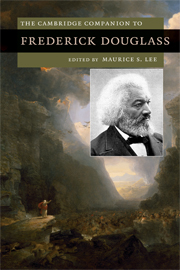Book contents
- Frontmatter
- Introduction
- 1 Douglass’s Self-Making and the Culture of Abolitionism
- 2 Identity in the Autobiographies
- 3 Douglass as Orator and Editor
- 4 Crisis and Faith in Douglass’s Work
- 5 Violence, Manhood, and War in Douglass
- 6 Human Law and Higher Law
- 7 Sentimental Douglass
- 8 Douglass among the Romantics
- 9 Douglass’s Black Atlantic: Britain, Europe, Egypt
- 10 Douglass’s Black Atlantic: The Caribbean
- 11 Douglass, Ideological Slavery, and Postbellum Racial Politics
- 12 Born into Slavery: Echoes and Legacies
- Guide to Further Reading
- Index
8 - Douglass among the Romantics
Published online by Cambridge University Press: 28 July 2009
- Frontmatter
- Introduction
- 1 Douglass’s Self-Making and the Culture of Abolitionism
- 2 Identity in the Autobiographies
- 3 Douglass as Orator and Editor
- 4 Crisis and Faith in Douglass’s Work
- 5 Violence, Manhood, and War in Douglass
- 6 Human Law and Higher Law
- 7 Sentimental Douglass
- 8 Douglass among the Romantics
- 9 Douglass’s Black Atlantic: Britain, Europe, Egypt
- 10 Douglass’s Black Atlantic: The Caribbean
- 11 Douglass, Ideological Slavery, and Postbellum Racial Politics
- 12 Born into Slavery: Echoes and Legacies
- Guide to Further Reading
- Index
Summary
The years in Frederick Douglass’s life between 1838 and 1860 represent a period of intellectual and personal growth. Having escaped from slavery in 1838, Douglass over the next two decades became one of the most renowned black abolitionists of the nineteenth century. His oratory and writing skills were so great that audiences who read his works or heard him speak did not believe that he had been a slave. Douglass’s 1845 Narrative of the Life of Frederick Douglass, An American Slave was meant to verify his life in slavery. When audiences at abolition rallies doubted his former slave status, Douglass would remove his jacket and expose his whip-scarred back. His narrative and his scars removed any doubts about his authenticity.
In order to fully appreciate Douglass’s intellectual growth between 1838 and 1860, it is necessary to look at the rise of an American literary tradition and the development of a unique strand or aspect of American social and political thought during these years. Douglass’s intellectual growth emerges during what has been called the American Romantic period or sometimes known as the American Renaissance. American Romanticism, though unique, also draws on British and German influences, especially the idealism of Immanuel Kant, who is particularly helpful in understanding Douglass.
Romanticism and Transcendentalism
It is the focus on the primacy of the individual that gives American Romanticism its particular ideological bent. Individual intuitive moral consciousness constitutes what it means to be human. Each individual is a rational thinking being with innate moral knowledge. Each individual is to be respected as a human being. The individual should be allowed to develop to the fullest of his or her ability. The individual is a part of nature and connected to all other individuals by this relationship.
- Type
- Chapter
- Information
- The Cambridge Companion to Frederick Douglass , pp. 118 - 131Publisher: Cambridge University PressPrint publication year: 2009
- 6
- Cited by



